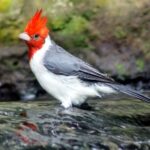Play is an essential part of a bird’s life. Birds engage in playful activities such as games of fetch or intricate dances to express joy, develop physical skills, and strengthen emotional bonds. By observing these playful interactions, people can better meet the needs of their feathered friends. They can ensure their birds are happy and healthy.
Introducing play into a bird’s routine also provides mental stimulation, which is vital for preventing boredom and related issues. Birds may play by hopping from perch to perch or engaging in flight activities that enhance their physical fitness. Owners who understand these behaviors can create enriched environments that cater to both the physical and emotional well-being of their birds.
Watching birds at play offers a unique window into their worlds. Through simple observation, enthusiasts can learn about bird behavior, vocalizations, and social interactions. This not only promotes compassion but also contributes to bird conservation efforts by fostering a deeper connection with these feathered creatures.
The Playful Side of Birds: Unveiling Their Intelligence and Social Bonds
Playfulness in birds is a captivating aspect of their behavior, offering a window into their intelligence, social dynamics, and overall well-being. While often associated with mammals, play is not exclusive to them. Birds engage in various forms of play, each serving unique purposes in their development and survival.
Forms of Avian Play
Avian play manifests in different ways, depending on the species and age of the bird. Common types of play observed in birds include:
- Object Play: Birds manipulate objects like twigs, leaves, or even shiny trinkets, exploring their textures, shapes, and properties. This interaction can enhance their problem-solving skills and understanding of their environment.
- Locomotor Play: Energetic activities like chasing, flying acrobatics, and playful dives showcase birds’ physical prowess and coordination. This play is crucial for developing muscles and honing flying skills, especially in young birds.
- Social Play: Interactions with other birds, such as mock fights, chasing games, or synchronized flights, are essential for establishing social bonds, learning communication cues, and practicing mating rituals.
The Science Behind Bird Play
Scientists believe that bird play serves multiple purposes:
- Skill Development: Play helps birds develop essential skills for survival, such as foraging techniques, predator evasion, and social interaction.
- Cognitive Enhancement: Engaging in play stimulates birds’ cognitive abilities, promoting problem-solving, creativity, and adaptability.
- Stress Reduction: Playful activities can serve as a healthy outlet for stress and pent-up energy, contributing to the overall well-being of birds.
- Social Bonding: Playful interactions strengthen social bonds within flocks, promoting cooperation and communication.
Play as an Indicator of Well-being
Observing play behavior in birds can offer valuable insights into their well-being. A bird that engages in frequent and varied play is likely to be healthy, both physically and mentally. Conversely, a lack of playfulness may signal stress, illness, or social isolation.
Play in Different Bird Species
Play behavior varies across bird species. Some species, like crows and parrots, are known for their highly intelligent and playful nature, engaging in complex games and problem-solving activities. Others, like waterfowl and raptors, may exhibit playfulness through aerial acrobatics and mock hunting behaviors.
Observing Bird Play: Tips for Birdwatchers
For birdwatchers, observing play behavior can be a rewarding experience. Here are some tips to enhance your observations:
- Look for Young Birds: Juvenile birds are more likely to engage in play than adults, as they are still developing their skills and social bonds.
- Observe in Groups: Social play is more likely to occur in groups of birds, so look for flocks of the same species.
- Be Patient: Play behavior can be sporadic, so be patient and observe for extended periods.
- Record Your Observations: Keeping a journal of your observations can help you identify patterns and learn more about bird behavior.
The Importance of Play for Captive Birds
For captive birds, providing opportunities for play is crucial for their physical and mental well-being. Environmental enrichment, such as toys, puzzles, and social interaction with other birds, can stimulate play behavior and prevent boredom and frustration.
Examples of Playful Bird Species
| Bird Species | Type of Play | Description |
|---|---|---|
| Crows | Object Play, Social Play | Crows are known for their intelligence and playful nature, engaging in complex games with objects and other birds. |
| Parrots | Object Play, Social Play | Parrots are highly social and playful, often mimicking sounds and engaging in interactive games with their owners and other parrots. |
| Ravens | Object Play, Locomotor Play | Ravens exhibit playful behaviors like rolling down snowy slopes, playing with objects, and engaging in aerial acrobatics. |
| Keas | Object Play | Keas, a type of parrot found in New Zealand, are known for their mischievous and curious nature, often dismantling objects and exploring their surroundings through play. |
Understanding bird behavior through play allows us to appreciate the intelligence, complexity, and social nature of these fascinating creatures. It also highlights the importance of providing opportunities for play, both in the wild and in captivity, to ensure their well-being and happiness.
Key Takeaways
- Play is crucial for a bird’s physical and emotional health.
- Observing play helps in understanding bird behavior.
- Engaging birds in playful activities prevents boredom and supports a healthy routine.
Exploring the Fundamentals of Bird Behavior
Exploring bird behavior requires examining their communication, survival strategies, courtship rituals, play, and methods for observation. These behaviors reveal how birds interact with others, adapt to environments, and raise their young.
Communication and Social Interactions
Birds communicate through songs, calls, and body language. They use vocalization to signal danger, attract mates, and establish territories. For example, songbirds sing complex tunes, while predators use calls to warn the flock. Social bonds are formed through preening and feeding others, which strengthens trust. Understanding these patterns helps in identifying bird species and their social structures.
Behavioral Adaptations for Survival
Birds have developed various adaptations to thrive. These include migration to find better food sources and avoid harsh climates. Some birds, like vultures, feed on carrion, while others hunt or forage. Behavioral adaptations also include flapping to escape predators, hopping to search for insects, and using tools to access food. These behaviors highlight their ability to survive in diverse habitats.
Reproductive Behaviors and Courtship
Courtship in birds involves complex rituals. Monogamous birds form pair bonds that last through breeding seasons. They build nests to raise young and display elaborate dances to attract potential mates. For example, sandhill cranes perform dances, while some species use bright plumage as a display. These behaviors ensure the continuation of their species and the emotional bonds with their mates.
The Role of Play in Avian Development
Play is crucial for young birds. Through play, fledglings learn survival skills like foraging and flying. It includes object play, such as manipulating sticks, and social play, like mock fighting. This behavior is essential in developing fitness and emotional well-being. Observing play in companion birds can help owners cater to their pets’ needs, enriching their lives.
Understanding and Observing Bird Behavior
Observing bird behavior requires patience and attention. Bird watching helps identify common behaviors like feeding, nesting, and flapping. Tips for observation include using binoculars, taking notes, and participating in citizen science projects. By studying these patterns, bird watchers contribute to conservation efforts and expand knowledge of avian behavior in various ecosystems.
Frequently Asked Questions
How birds play can tell us a lot about their emotions and health. Play helps ensure birds stay happy and active.
What are typical play behaviors observed in birds?
Birds often love to climb, swing, and chew on toys. Some enjoy games of fetch, while others perform intricate flights or dances. Each play activity reflects their natural behaviors and needs.
How do different bird species engage in play?
Parrots are known for mimicking and interacting with toys and humans. Smaller birds, like finches, may prefer flitting between perches or playing with feathers and leaves. Different species have their own unique play styles.
What can be learned about bird psychology through their play behavior?
Play reveals a bird’s mental state, showing signs of joy or stress. By watching how birds engage with their environment, owners can identify changes in their emotional well-being and take steps to improve their health.
Why is play behavior in birds important for their wellbeing?
Play keeps birds mentally and physically stimulated. It mimics the activities they would do in the wild, such as foraging and flying. Engaged birds are healthier, less prone to anxious behaviors, and live longer.
How can observing play behavior aid in bird conservation efforts?
Understanding play helps conservationists create better environments for birds in captivity. It also aids in reintroducing birds to the wild by ensuring they retain necessary survival skills learned through play.
What methods are used by researchers to study play behavior in birds?
Researchers use direct observation and video recordings. Toys and interactive setups in controlled environments help scientists study how birds play. This data is crucial for improving both avian care and conservation practices.






